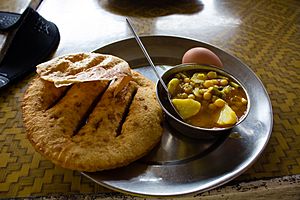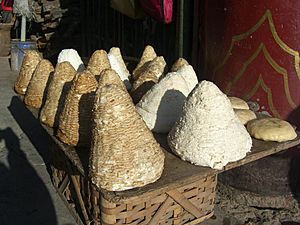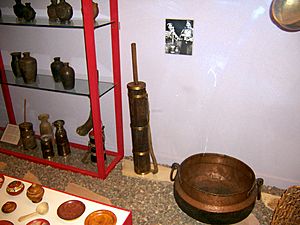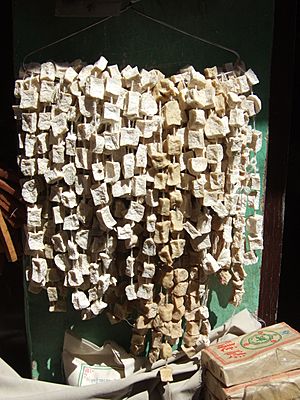Tibetan cuisine facts for kids
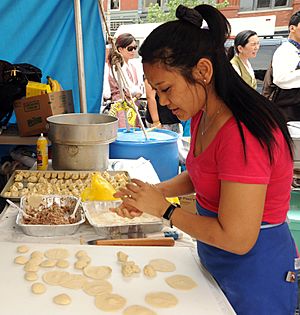
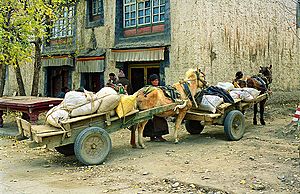
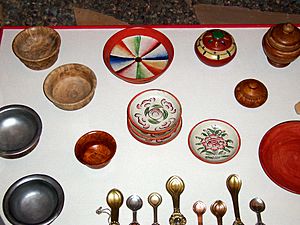
Tibetan cuisine is all about the food traditions and cooking styles of the people in Tibet. This food shows off the high mountains and plateaus of Tibet. It also has ideas from nearby countries like India and Nepal.
Tibetan food often uses noodles, goat meat, yak meat, and mutton. You'll also find dumplings, Tibetan cheese (often from yak or goat milk), butter, and yogurt. Soups are also very popular. It's hard to grow many vegetables in Tibet's high altitude. Because of this, meat is a big part of the traditional diet.
The most important crop in Tibet is barley. A special flour made from roasted barley is called tsampa. This is the main food for Tibetans. Other popular foods include Sha phaley, which is meat and cabbage baked in bread. Balep is a type of Tibetan bread eaten for breakfast and lunch.
Thukpa is a common dinner. It's a soup with vegetables, meat, and different kinds of noodles. Tibetans usually eat with bamboo chopsticks. This is different from other Himalayan foods, which are often eaten by hand. Mustard seeds are also grown and used a lot in Tibetan cooking.
Outside of Tibet, you can find Tibetan food in parts of India like Ladakh and Sikkim. It's also eaten in northern Nepal and by Tibetans living in other countries. In bigger Tibetan towns, you might find restaurants serving Chinese food. Western dishes like fried yak and chips are also becoming popular. Still, many small restaurants continue to serve traditional Tibetan meals.
Contents
Food Culture in Tibet
Cooking Tools
Tibetans use many kinds of pots, pans, and containers. Women often carry large wooden containers to get water. These can hold up to 25 liters. Back home, they pour the water into big copper cans that hold over 100 liters. Cooking pots are usually made from iron or brass.
Wooden boxes are used to store important foods like tsampa, butter, and cheese. Tibetans also have beautiful woven baskets with lids. They use these to store dried fruits, rice, and sugar. When people travel, they use these baskets to carry dried meat and cheese. In Southern Tibet, special tools called mortars are used to crush chili peppers.
Eating Utensils
Traditional Tibetan eating bowls are made from wood. Sometimes, they use clay with a shiny finish. Families often pass down the skill of making these bowls. Wealthy people used to buy fancy porcelain bowls from other places. Today, many use porcelain from China or other countries.
Chopsticks were either made at home or brought in from forested areas. Rich families sometimes had ivory chopsticks with silver decorations. Spoons are very important for most dishes. People who were poor, and children, sometimes wore spoons around their necks. This made sure they always had a spoon ready! Knives are sometimes used for eating fruits.
Tibetan Tea Traditions
Teacups are sometimes carried inside the traditional Tibetan clothing called a Chuba. Wooden teacups made from dzabija wood are highly valued. They are smooth, have beautiful wood patterns, and are comfortable to hold. These cups are expensive, so not everyone can afford them.
Fancy teacups often have a silver lining inside. This makes them easier to clean. Rich people and high lamas used special stands and lids for their cups. These lids were decorated with amazing designs. They help keep the tea's smell inside. The most valuable cups are made from white jade. They do not have handles. The best teacups are made of metal or silver. These are used only for guests or on special festival days.
Teapots are usually made of wood or clay. The nicer ones are made from decorated metals like copper or brass.
The Dongmo is a special wooden tool used to make Tibetan butter tea. It holds about 4 liters and is decorated with brass. A whisk is put into a hole on top. By moving it up and down 15-20 times, the butter and tea mix together smoothly.
Monastery Kitchens
Tibetan monks usually cook for themselves. They also earn money by praying for farmers or performing rituals for families. In monastery kitchens, very large pots are used to make soups. During breaks from their studies, monks are served tea and soup. Younger monks walk around, pouring tea from beautiful teapots.
Tibetan Etiquette
Tibetan manners are based on being friendly, welcoming, and helpful. These ideas come from Tibetan Buddhism. Being selfish is seen as wrong. Helping others is highly valued. Tibetans also believe in Karma. This means they think everything that happens comes from past actions. This helps them deal with sadness or bad luck. They believe it helps them clear bad karma.
When you visit a Tibetan home, you will see this kindness. When you arrive, you might get a Khata. This is a white silk scarf. It shows happiness for your visit and respect for you. Once inside, the host will make sure you are comfortable. They will often offer you tea. It's polite to say no at first. But the host will quickly serve the tea anyway.
The host (usually the woman of the house) will pour and give you the cup with both hands. This shows respect. You should take a small sip and then put the cup down. The host will fill it again and ask you to drink. This happens two more times before you slowly finish the cup. If you leave the cup full without drinking, it means you are happy and have had enough. The cup will then be taken away. You might then be offered Chang, which is barley beer.
At the table, people sit with their legs crossed. It is rude to stretch your legs out. Also, you should never step over someone's body part. Pastries might be served with tea. If you are offered a meal, you can politely refuse at first. After offering again, the host might ask what you would like. The main goal of any host is to make guests feel relaxed and happy.
Popular Tibetan Dishes
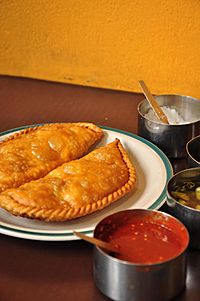
Here are some other Tibetan foods:
- Sha Phaley - Bread filled with seasoned beef and cabbage. It's shaped like a half-moon or circle and can be deep-fried or pan-fried.
- Balep korkun - A flatbread from central Tibet. It's cooked on a skillet, not in an oven.
- Tingmo (food) - A type of steamed bun. It's a bit heavier than Chinese baozi.
- Thenthuk - A soup for cold weather. It has noodles and different vegetables.
- Shab Ta - Stir-fried meat with celery, carrots, and fresh green chili.
- Gyurma (Juema) - A blood sausage made with yak or sheep's blood and roasted barley flour or rice.
- Sokham Bexe - Fried dough with butter and minced meat. It's said to be a favorite of the Dalai Lama.
- Dtowa Katsa - Stewed tripe with curry, fennel, and salt.
- Lunggoi Katsa - Stewed sheep's head with curry, fennel, and salt.
- Tu (cake) - A cheese cake pastry made with yak butter, brown sugar, and water.
- Masan - A pastry made with tsampa, dry cheese, yak butter, brown sugar, and water.
- Xogoi Momo - A type of momo made with mashed potato and dough. It's shaped into balls with a minced meat filling.
- Léphing - A spicy mung bean noodle dish often sold by street vendors.
Breads and Fried Dough
- Papza Mogu - Dough balls with melted butter, brown sugar, and dry curd cheese. They taste sweet and sour and are red.
Soups
- De-Thuk - A type of thick soup (gruel) with yak or sheep broth, rice, and different Tibetan cheeses.
- Tsam-thuk - Another thick soup using yak or sheep broth, roasted barley flour, and various Tibetan cheeses.
- Thukpa bhatuk - A common Tibetan noodle soup made with small, round noodles.
Sweet Treats
- Day-see - A sweet Tibetan dish with rice cooked in unsalted butter. It's mixed with raisins, droma (a root), dates, and nuts. This dish is usually served only during Losar (Tibetan New Year).
- Khapsey - Tibetan cookies or biscuits that are deep-fried. They are made for celebrations like Tibetan New Year or weddings. Khapseys come in many different shapes and textures. Some are sprinkled with powdered sugar.
Holiday Dishes
- Guthuk - This soup is traditionally eaten before Losar.
- Khapse - Special pastries for Losar are called nyapsha.
Cheeses, Yogurt, and Butter
Tibetan cheeses, yogurt, and butter are very important foods. There are soft cheese curds like cottage cheese made from buttermilk. These are called chura loenpa. Hard cheese is called chura kampo. An extra hard cheese, made from firm yogurt, is called chhurpi. You can also find this in Sikkim and Nepal.
Another cheese called shosha or churul tastes a bit like Limburger cheese. It is made from cream and the skin of milk.
Drinks
Most Tibetans drink many cups of yak butter tea every day. Jasmine tea is also sometimes available.
Butter tea is the national drink. It's perfect for the cold, high conditions of the Tibetan plateau because it has a lot of butter. This gives people energy and warmth.
Even though butter tea is the most popular, black tea is also quite common. Jasmine grows in Eastern Tibet. Tibetans likely learned about jasmine tea from the Chinese. Spice tea is very popular among Tibetans living in India and Nepal. However, it is almost unknown in Tibet itself. It was probably adopted from Indian culture.
Dara is the Tibetan word for buttermilk. It refers to a yogurt drink. It's also used for Indian Lassi.
Alcoholic Drinks
Traditionally, Tibetan Buddhism did not allow drinking alcohol. However, beer is made mostly from barley. Rice, wheat, corn, oats, and millet are also used to make beer. Chang is a type of beer often drunk through a thin bamboo straw.
Some alcoholic drinks include:
- Beer
- Chang, a beer usually made from barley.
- Pinjopo, a rice wine.
- Ara, which is a strong drink made from grains.
Main Ingredients
Barley has been a staple food in Tibet since the 5th century AD. It is made into a flour called tsampa, which is still a main food today. The barley flour is roasted and mixed with butter and butter tea. This makes a stiff dough that is eaten in small balls.
See also
 In Spanish: Gastronomía del Tíbet para niños
In Spanish: Gastronomía del Tíbet para niños


